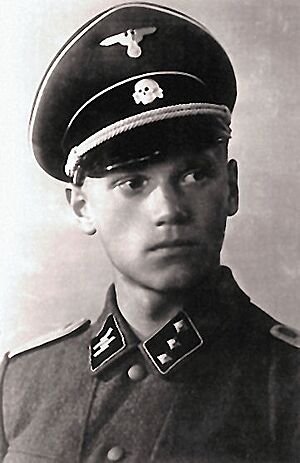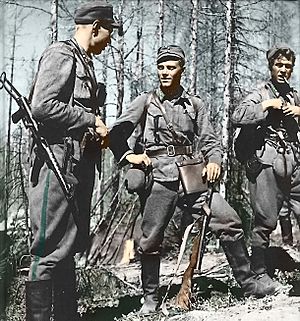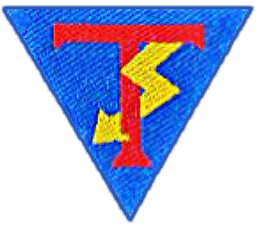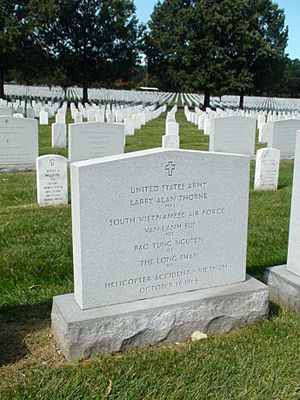Lauri Törni facts for kids
Quick facts for kids
Lauri Allan Törni, "Lasse"
Larry Thorne |
|
|---|---|
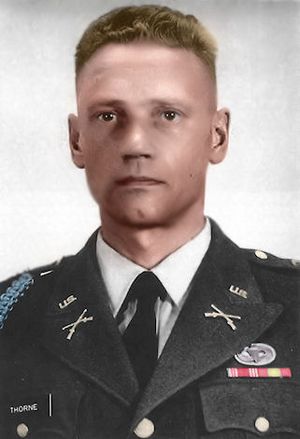
Larry Thorne in the U.S. Army
|
|
| Nickname(s) | Lasse |
| Born | May 28, 1919 |
| Died | October 18, 1965 (aged 46) |
| Buried at | |
| Allegiance | Finland United States of America |
| Service/ |
Finnish Army Waffen SS United States Army |
| Years of service | 1938–1944 (Finnish Army) 1945 (Waffen SS) 1954–1965 (U.S. Army) |
| Rank | Captain (Finland) Hauptsturmführer (Germany) Major (USA) |
| Unit | Infantry Regiment 12 (Finland) Sondercommando Nord (Germany: January–April 1945) Green Berets, Detachment A743, MACV-SOG 5th Special Forces Group (Airborne) |
| Battles/wars | World War II
|
| Awards | Mannerheim Cross Iron Cross 2nd Class Bronze Star Purple Heart (2) Distinguished Flying Cross |
Lauri Allan Törni (born May 28, 1919 – died October 18, 1965) was a brave Finnish soldier. He later became known as Larry Thorne in the United States. He led an infantry company during the Winter War and Continuation War in Finland. These were parts of World War II.
After the wars, he moved to the United States. He joined the American Army there. Lauri Törni is famous for fighting under three different flags. He fought for Finland, Germany (briefly against the Soviets in World War II), and the United States. In the U.S. Army, he served in the Special Forces, also known as the Green Berets. He fought in the Vietnam War.
Contents
Early Life and Military Start
Lauri Allan Törni was born in Viipuri, Finland. His father was a ship captain. Lauri had two younger sisters. As a boy, he was very athletic. One of his early friends later became an Olympic boxing champion.
Lauri went to business school. He also served in the Finland Civil Guard. Later, he joined the Finnish military. He became part of the 4th Independent Jaeger Infantry Battalion.
Military Career Highlights
World War II Service
During the Winter War, Lauri Törni fought in battles near Lake Ladoga. His commanders noticed his great courage. After the war, he received officer training. He became a second lieutenant in the reserves.
In June 1941, Törni went to Vienna, Austria. He received seven weeks of training with the Waffen SS. He returned to Finland in July. Because he was a Finnish officer, he was also recognized as a German officer.
Törni became very famous for his bravery in the Continuation War (1941–44). This war was fought between the Soviet Union and Finland. In 1943, he led a special infantry unit called Detachment Törni. His unit would go behind enemy lines to attack Russian forces.
One of Törni's soldiers was Mauno Koivisto. Koivisto later became the President of Finland. They fought together in the Battle of Ilomantsi. This was the last major battle between Finland and the Soviet Union in the Continuation War.
Törni's unit caused many problems for the Russian forces. The Soviet Army even offered a reward of 3 million Finnish Marks to anyone who could capture him. This was a lot of money, about 650,000 U.S. dollars at the time. For his courage, Törni received the Mannerheim Cross on July 9, 1944. This was a very high honor in Finland.
Finland made peace with the Soviets. This peace deal meant Finland had to fight against Germany in the Lapland War. Törni was not happy about this. He left the Finnish Army. In 1945, he joined a group that wanted to organize resistance if the Soviet Union occupied Finland. He went to Germany for training.
At the end of World War II, he surrendered to British troops in Germany. He returned to Finland in June 1945. After returning, he was arrested by the Finnish national security agency. He faced charges because he had joined a group connected to Germany. He was sent to prison in 1947. He escaped once but was recaptured. In December 1948, the Finnish President Juho Kusti Paasikivi gave him a pardon.
Joining the United States Army
In 1949, Törni traveled to Sweden. He then went to Caracas, Venezuela. From there, he got a job on a Swedish cargo ship, the MS Skagen. The ship sailed to the United States in 1950. While the ship was near Mobile, Alabama, Törni jumped overboard. He swam to shore and became a political refugee.
He went to New York City. The Finnish-American community there helped him. He worked as a carpenter and cleaner. In 1953, a special law helped Törni get permission to live in the U.S.
Törni joined the United States Army in 1954. A special law allowed non-citizens to join the army. He changed his name to Larry Thorne. In the U.S. Army, he joined the Special Forces, also known as the Green Berets. He taught skills like skiing, survival, mountaineering, and guerrilla warfare. He also went to airborne school.
He quickly rose through the ranks. He became a second lieutenant in 1957 and a captain in 1960. From 1958 to 1962, he served in West Germany. He was part of a difficult search and rescue mission in the Zagros Mountains of Iran. Thorne was praised for his success in this mission.
In November 1963, Thorne joined a Special Forces unit in Vietnam. He fought bravely in the Mekong Delta. He received medals for his courage there.
In 1965, Thorne joined a secret U.S. special operations unit called MACV–SOG. This unit focused on special missions in Vietnam. On October 18, 1965, Thorne was on a secret mission. He was supervising from a helicopter. The helicopter crashed in a mountainous area of Vietnam. A rescue team tried to find the crash site but could not because of the thick mountains and trees.
Soon after he disappeared, Larry Thorne was promoted to the rank of major.
Thorne's body was found in 1999, along with the bodies of the helicopter crew. They were officially identified in 2003. On June 26, 2003, he was buried at Arlington National Cemetery. The remains of the other soldiers from the crash were buried with him.
Larry Thorne's Legacy
In the 1990s, Lauri Törni became more and more famous as a war hero. Several books were written about his life. He was named 52nd in a list of famous Finns. In 2006, a Finnish magazine called him the most courageous recipient of the Mannerheim Cross.
In Finland, the people who served with Detachment Törni formed a group called the Lauri Törni Tradition Guild. The Infantry Museum in Mikkeli, Finland, has an exhibit about Törni. The Military Museum of Finland in Helsinki also has one. Törni is seen as a main hero by Finland's elite army groups, the Finnish Parachute Rangers and Coastal Rangers.
In the United States, a building at Fort Carson, Colorado, is named the Larry Thorne Headquarters Building. The Special Forces 10th Group gives out the Larry Thorne Award each year. This award goes to the best Special Forces team. The Special Forces Association Chapter 33 in Cleveland, Tennessee, is also named after him. In 2010, he was named the first Honorary Member of the United States Army Special Forces Regiment.
A character in the book The Green Berets by Robin Moore was based on Larry Thorne.
Some historians have discussed Törni's actions at the end of World War II. They have different ideas about why he joined certain groups. However, members of the Törni Heritage Guild believe he was always motivated by patriotism for Finland.
Images for kids
See also
 In Spanish: Lauri Törni para niños
In Spanish: Lauri Törni para niños


